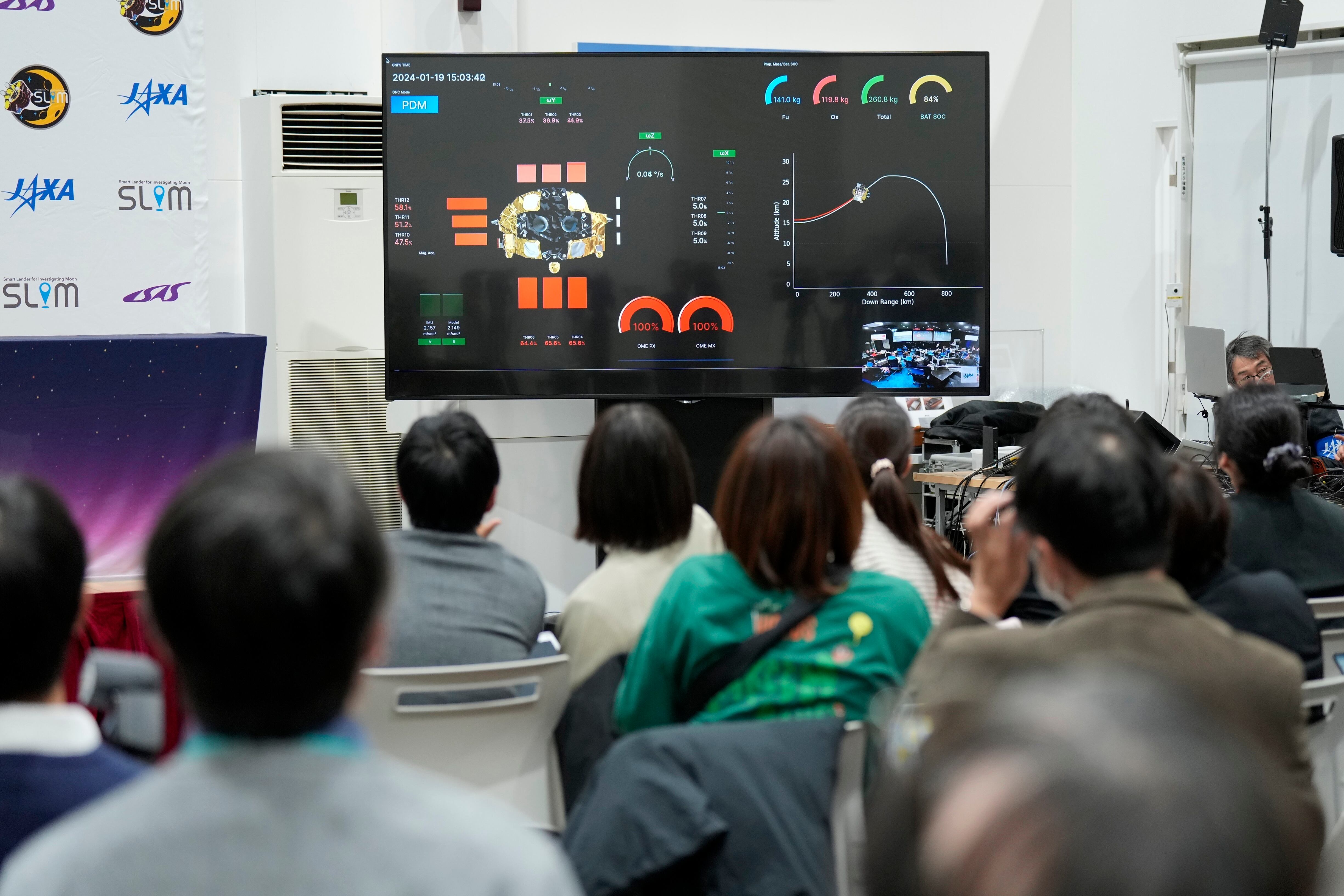Japan became the fifth country in history to reach the moon when its spacecraft landed on the lunar surface early Saturday, officials said. But an issue with the power supply means that the mission could be in jeopardy.
Officials also said they needed more time to analyze whether the spacecraft, which wasn't carrying astronauts, made a pinpoint landing — one of the priorities of the mission.
Hitoshi Kuninaka, head of the Institute of Space and Astronautical Science, said they believe that rovers were launched and data were being transmitted back to Earth from the Smart Lander for Investigating Moon, or SLIM.
But he said that SLIM's solar battery wasn't generating power and the battery life of the spacecraft would only last a few more hours. He said that the priority now was for the craft to gather as much moon data as possible on the remaining battery.
Japan follows the United States, the Soviet Union, China and India in reaching the moon.
Kuninaka said he believes that Japan's space program at least achieved “minimum” success.
SLIM landed on the moon at about 12:20 a.m. Tokyo time on Saturday (1520 GMT Friday).
There was a tense wait for news after the Japan space agency's mission control initially said that SLIM was on the lunar surface, but that it was still “checking its status.” No further details were given until a news conference nearly two hours later.
For the mission to be considered fully successful, space officials need to confirm whether SLIM made a pinpoint landing. Kuninaka said while more time is needed, he personally thinks it was most likely achieved, based on his observation of data showing the spacecraft's movement until the landing.
SLIM, which was aiming to hit a very small target, is a lightweight spacecraft about the size of a passenger vehicle. It was using “pinpoint landing” technology that promises far greater control than any previous moon landing.
While most previous probes have used landing zones about 10 kilometers (six miles) wide, SLIM was aiming at a target of just 100 meters (330 feet).
The project was the fruit of two decades of work on precision technology by Japan Aerospace Exploration Agency, or JAXA.
As the spacecraft descended, JAXA's mission control said that everything was going as planned and later said that SLIM was on the lunar surface. But there was no mention of whether the landing was successful. Mission control kept repeating that it was “checking its status" and that more information would be given at the news conference.
SLIM, nicknamed "the Moon Sniper," started its descent at midnight Saturday, and within 15 minutes it was down to about 10 kilometers (six miles) above the lunar surface, according to the space agency, which is known as JAXA.
At an altitude of five kilometers (three miles), the lander was in a vertical descent mode, then at 50 meters (165 feet) above the surface, SLIM was supposed to make a parallel movement to find a safe landing spot, JAXA said.
The mission's main goal is to test new landing technology that would allow moon missions to land “where we want to, rather than where it is easy to land,” JAXA has said. The spacecraft is supposed to seek clues about the origin of the moon, including analyzing minerals with a special camera.
The SLIM, equipped with a pad to cushion impact, was aiming to land near the Shioli crater, near a region covered in volcanic rock.
The closely watched mission came only 10 days after a moon mission by a U.S. private company failed when the spacecraft developed a fuel leak hours after the launch.
SLIM was launched on a Mitsubishi Heavy H2A rocket in September. It initially orbited Earth and entered lunar orbit on Dec. 25.
Japan hopes to regain confidence for its space technology after a number of failures. A spacecraft designed by a Japanese company crashed during a lunar landing attempt in April, and a new flagship rocket failed its debut launch in March.
JAXA has a track record with difficult landings. Its Hayabusa2 spacecraft, launched in 2014, touched down twice on the 900-meter-long (3,000-foot-long) asteroid Ryugu, collecting samples that were returned to Earth.
Experts say a success of SLIM's pinpoint landing, especially on the moon, would raise Japan's profile in the global space technology race.
Takeshi Tsuchiya, aeronautics professor at the Graduate School of Engineering at the University of Tokyo, said it was important to confirm the accuracy of landing on a targeted area for the future of moon explorations.
“It is necessary to show the world that Japan has the appropriate technology in order to be able to properly assert Japan's position in lunar development,” he said. The moon is important from the perspective of explorations of resources, and it can also be used as a base to go to other planets, like Mars, he said.
SLIM is carrying two small autonomous probes — lunar excursion vehicles LEV-1 and LEV-2, which will be released just before landing.
LEV-1, equipped with an antenna and a camera, is tasked with recording SLIM's landing. LEV-2, is a ball-shaped rover equipped with two cameras, developed by JAXA together with Sony, toymaker Tomy and Doshisha University.
JAXA will broadcast a livestream of the landing, while space fans will gather to watch the historic moment on a big screen at the agency's Sagamihara campus southwest of Tokyo.













